We, counting my fine apprentice, have wanted for some time to make an olive bread that was loosely based on Nancy Silverman’s fine loaf that she did with Julia Child on Baking With The Masters. But, since the girls at home despise olives except for olive oil, this want has gone unfulfilled for what seems like forever.
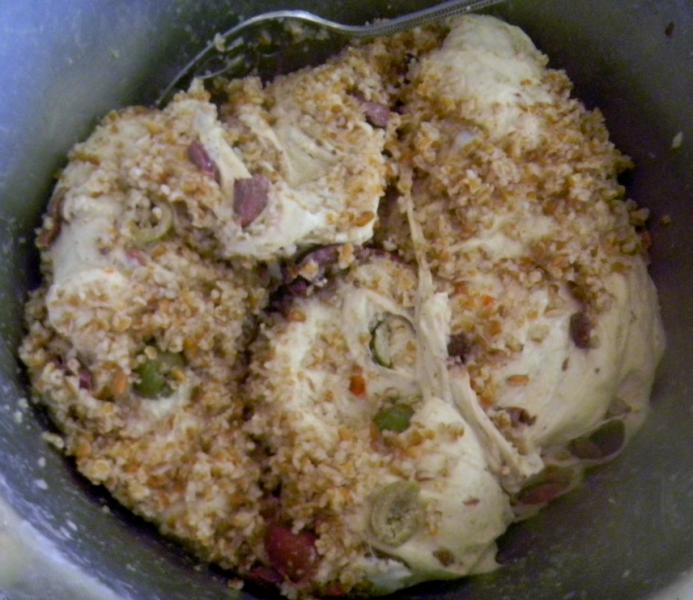
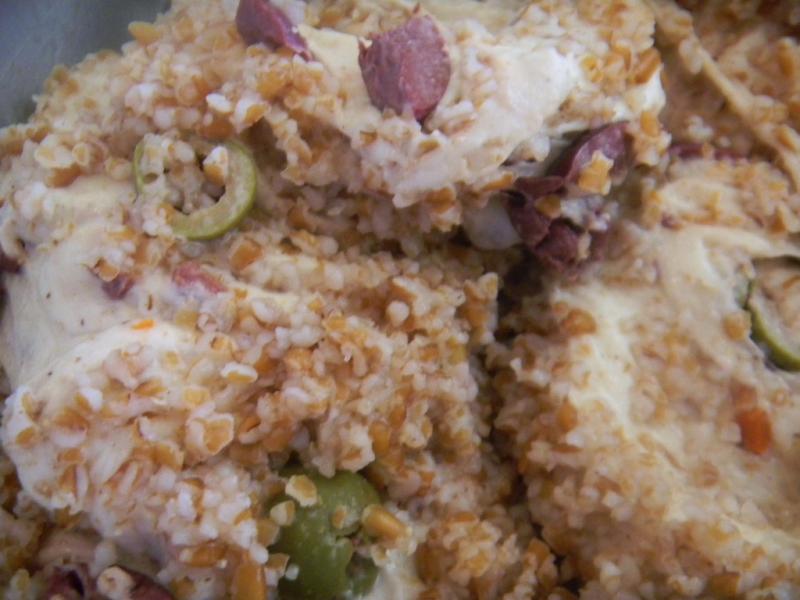
But, today the evil veil of olive hatred was lifted just enough, to allow an olive loaf to breathe a breath of yeasty CO2 without being killed outright by evil doers before the scald, add ins and olives could be incorporated.


We wanted a bread that had 20% whole grains and some rosemary that pairs so well with olives. We also wanted some cracked bulgar berries that were scalded. No sprouts this time - using them to make white diastatic malt instead. The bread would possibly have been better with sprouts and seeds or nuts – maybe next time.


A mixture of 95% kalamata and 5% green martini olives were used. The salt was kept down a bit since the olive brought plenty of their own. The total hydration was around 70% which is a little low for us but the scald and olives brought some extra liquid that was un accounted for in the formula. The dough felt like it was around 72% hydration but it is harder to tell with all the olives.
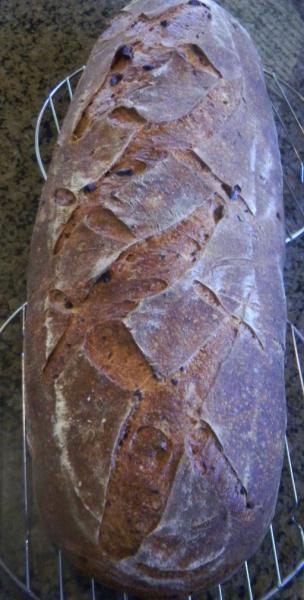

The diamond scoring pattern was helped along by refrigerating the large 3.7 pound batard for 3 hours after it had final proofed to 95% or so. We wanted a huge loaf since no one could know when we would be allowed to make another one - with olives in it.
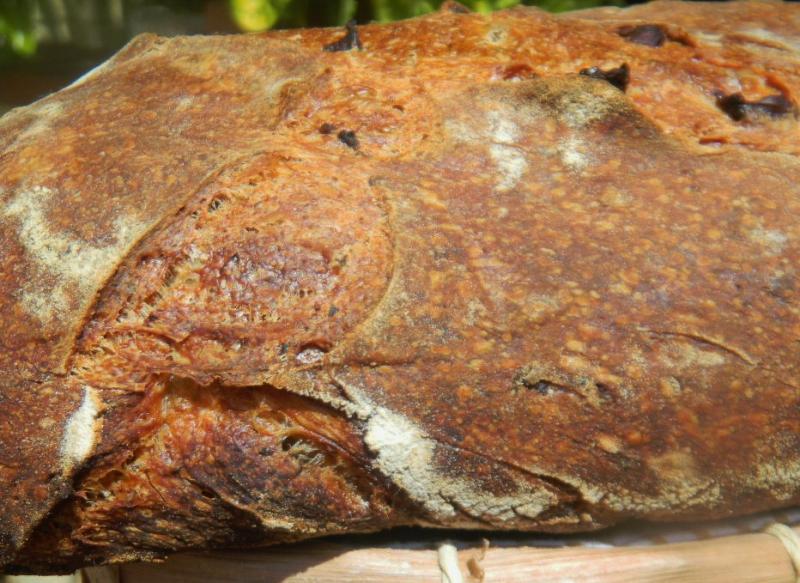
There was no way this was going to fit in the mini oven. With it only being 106 F today, a full 10 degrees less than last few days, we felt it was a real cold spell that we should take advantage of - so Betsy was fired up to 500 F with steamers and stone in place. The batard baked up deeply brown and very crispy in the Big GE oven using (2) of Sylvia’s steam pans with towels.
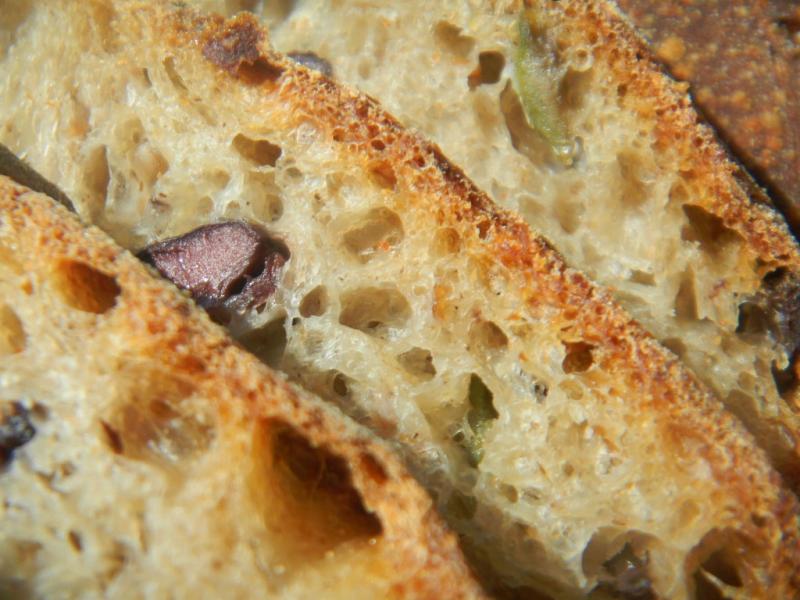

The crust was thick and the extra drying with the oven door ajar kept the crust crispy even after it cooled. The crumb was light, moist, a little glossy and fairly open with all the bran, whole grains and add ins. Best of all this bread tastes wonderful. It was just what we were looking for - with the exception of the sprouts, 50 g more olives and some pistachio nuts that we will add next time to gild the lily and turn this into just the kind of bread my apprentice drools over. It is super just as it is though.

Method
The YW and multi-grain SD starters were built separately over (2) 3 hour builds and then combined. The water, flour and salt were autolysed for 2 hours,. All the rest of the ingredients were then added except the bulgar scald and chopped olives.
The dough was kneaded for 4 minutes and then placed into an oiled bowl to rest. (4) sets of S & F’s, 15 minutes apart, were done on and oiled counter with the scald and olives incorporated in the 3rd set. They were well incorporated by the 4th set. The dough was allowed to ferment and develop on the counter for 90 minutes.

It was then pre-shaped into a large batard, rested for 10 minutes, final shaped and placed into a rice floured and cloth lined basket, placed in a tall kitchen plastic trash bag to proof. It was immediately refrigerated for 14 hours.
The dough increased in volume 57.3 % in the fridge overnight. It was allowed to come to room temperature and proof an additional 2 hours total getting to the 92.6% proof mark before refrigerating again for 3 hours. This extra retardation would not normally be required but the intracacies of life come first. Not really but it sounds so right and good.

The oven was preheated to 500 F with steam for 45 minutes before the dough was removed from the fridge, un-molded from the basket onto parchment and a peel, slashed and placed on the stone for baking. The oven was immediately turned down to 450 F and steamed for 15 minutes. The steam was removed and the temperature turned down to 425 F convection this time. The batard was rotated 180 degrees every 5 minutes for another 30 minutes until it tested 205 F in the center.
The oven was turned off and the bread was allowed to crisp on the stone with the oven door ajar for 12 minutes before being removed to a cooling rack. The batard rose to 209 F while crisping on the stone.
The formula follows the pix's
| Combo Starter Olive Bread with Rosemary and Bulgar Scald | | | | |
| | | | | |
| Mixed Starter | Build 1 | Build 2 | Total | % |
| SD Starter | 25 | 0 | 25 | 2.86% |
| Durum atta | 25 | 0 | 25 | 3.28% |
| Steel cut oats | 0 | 10 | 10 | 1.31% |
| 6 grain cereal | 0 | 10 | 10 | 1.64% |
| Ground Flax Seed | 0 | 5 | 5 | 0.66% |
| Bran | 0 | 5 | 5 | 0.66% |
| AP | 40 | 0 | 40 | 5.25% |
| Oat bran | 0 | 5 | 5 | 0.66% |
| Yeast Water | 40 | 0 | 40 | 5.25% |
| Water | 25 | 35 | 60 | 7.87% |
| Total Starter | 155 | 70 | 225 | 29.53% |
| | | | | |
| Starter | | | | |
| Hydration | 100.00% | | | |
| Levain % of Total Weight | 13.42% | | | |
| | | | | |
| Dough Flour | | % | | |
| Diastatic Malt | 3 | 0.39% | | |
| Durum Atta | 25 | 3.28% | | |
| 6 Grain Cereal | 44 | 5.77% | | |
| White WW | 35 | 4.59% | | |
| Bread Flour | 300 | 39.37% | | |
| AP | 355 | 46.59% | | |
| Dough Flour | 762 | 100.00% | | |
| | | | | |
| Salt | 13 | 1.71% | | |
| Water | 497 | 65.22% | | |
| Dough Hydration | 65.22% | | | |
| | | | | |
| Total Flour | 874.5 | | | |
| Water | 609.5 | | | |
| T. Dough Hydration | 69.70% | | | |
| Whole Grain % | 19.95% | | | |
| | | | | |
| Hydration w/ Adds | 69.70% | | | |
| Total Weight | 1,676 | | | |
| | | | | |
| Add - Ins | | % | | |
| Kalamata Olives | 102 | 13.39% | | |
| Dried Rosemary | 2 | 0.26% | | |
| Total | 104 | 13.65% | | |
| | | | | |
| Scald | | % | | |
| Cracked Bulgar | 30 | 3.94% | | |
| | | | | |
| If we would have put in Sprouts | | % | | |
| WW | 15 | 1.97% | | |
| Rye | 15 | 1.97% | | |
| Spelt | 15 | 1.97% | | |
| Total Sprouts | 45 | 5.91% | | |
